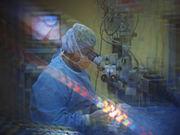Second study shows that different melanomas have distinct RCM morphological characteristics
FRIDAY, Sept. 2, 2016 (HealthDay News) — Reflectance confocal microscopy (RCM) best identifies skin cancer lesions on the head and neck, and RCM morphologic patterns differ for distinct melanomas, according to two studies published online Aug. 31 in JAMA Dermatology.
Stefania Borsari, M.D., from Arcispedale Santa Maria Nuova-IRCCS in Reggio Emilia, Italy, and colleagues identified lesions for which RCM performs better in terms of diagnostic accuracy. A total of 1,279 equivocal skin lesions from 1,147 patients were sent for RCM imaging. The researchers found that the RCM sensitivity and specificity were 95.3 and 83.9 percent, respectively. To rule out a melanoma, the number needed to excise was 2.4. Head and neck was the most appropriate body location for confocal examination; RCM showed high diagnostic accuracy for lesions located on sun-damaged skin (adjusted odds ratio, 2.13).
Thaís Corsetti Grazziotin, M.D., Ph.D., from the Universitat de Barcelona in Spain, and colleagues characterized RCM morphologic patterns of 57 melanomas from 50 patients. The researchers found that older age at diagnosis, phototypes 2 and 3, more intense solar exposure, and moderate to severe solar lentigines characterized dendritic cell melanoma. In facial lesions, it was the most prevalent confocal type and correlated with lentigo maligna histologic subtype. Round cell melanomas were more often identified in the familial context and in individuals with phototype 1 skin types. This subtype more often had RCM features, including junctional thickening, dense dermal nests, and nucleated cells with papillary dermis.
“The morphologic expression of melanomas via dermoscopy and confocal examination varies according to differences in tumor stage and biological behavior,” Grazziotin and colleagues write.
Copyright © 2016 HealthDay. All rights reserved.








